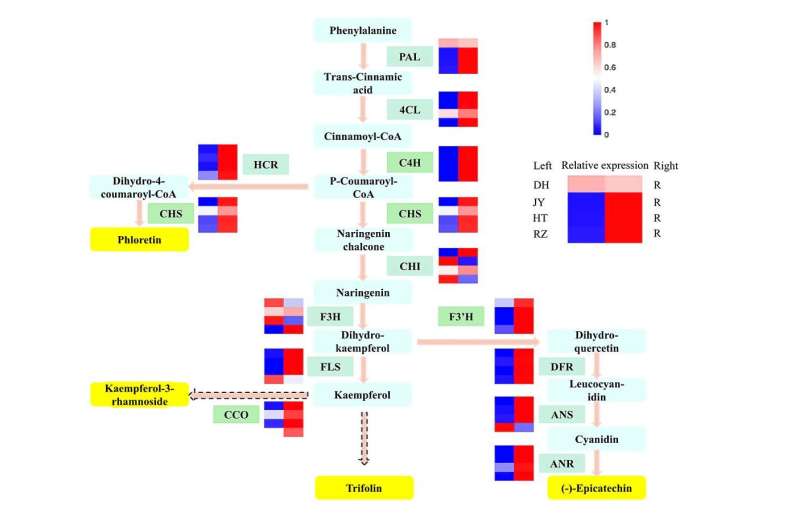The regulatory network of flavonoid biosynthesis. Credit: WBG
Kiwifruit (Actinidia chinensis) is a kind of nutritious fruit with a good commercial value. In recent years, kiwifruit roots and fruits have been found to have good medicinal properties. Although previous studies have investigated the function of some metabolites in kiwifruit, few have elucidated the differences in the metabolites between the root and fruit of different representative varieties.
Researchers from the Wuhan Botanical Garden of the Chinese Academy of Sciences conducted a metabolomic analysis on the roots and different varieties of red, green, and yellow kiwifruit flesh. They found that the root could be separated from the fruit samples based on the differences in metabolites. The results were published in the International Journal of Molecular Sciences, titled "Comprehensive Analysis of Metabolome and Transcriptome in Fruits and Roots of Kiwifruit."
A total of 410 metabolites were identified in the fruit and root tissues, 54 differentially expressed metabolites were shared between the root and each fruit sample, 17 of which were detected in the flavonoid pathway.
Four differential metabolites, including three flavonols (kaempferol-3-rhamnoside, L-Epicatechin and trifolin) and one dihydrochalcone (phloretin), were identified, which were highly abundant in kiwifruit roots. Phloretin can block tumor cell growth and induce apoptosis, and flavonols are beneficial for cardiovascular and cerebrovascular disease. Therefore, flavonols and phloretin may be important components of kiwi root in traditional Chinese medicine.
The genes related to flavonols and dihydrochalcones were highly expressed in the root, and four candidate structural genes (AcC4H, AcCHS, AcF3'H, and AcCCO) and three transcription factor genes (AcRAP2-4, AcAP2-4 and AcbHLH62) were identified.
The results of the RT-qPCR analysis showed that AcC4H, AcCHS, AcF3'H, AcCCO, AcRAP2-4 and AcAP2-4 were significantly more highly expressed in the roots than in the fruits, while AcbHLH62 showed extremely low expression in roots.
This study determines the differences in the metabolites between the roots and fruits of different kiwifruit varieties, and identifies candidate genes related to functional metabolites in the flavonoid biosynthesis pathway.
The differences in the metabolite profiles between roots and fruits and the variation among kiwifruit varieties facilitate the application of kiwifruit in the field of pharmacy and processing.
More information: Long Zhang et al, Comprehensive Analysis of Metabolome and Transcriptome in Fruits and Roots of Kiwifruit, International Journal of Molecular Sciences (2023). DOI: 10.3390/ijms24021299
Provided by Chinese Academy of Sciences
























